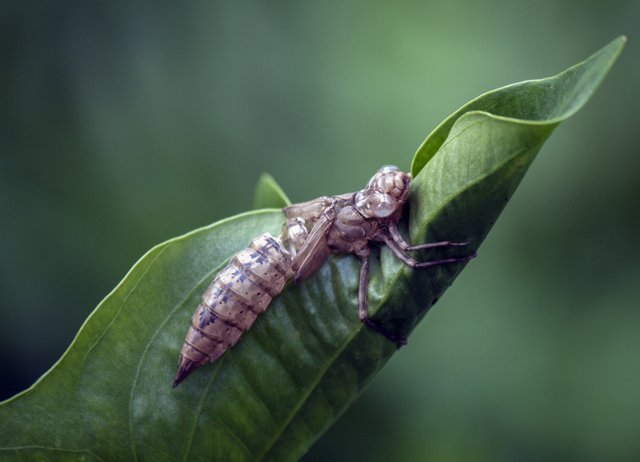Dragonflies are undoubtedly one of the natural world's design classics with a superbly adapted body plan and behavior repertoire that has stood the test of time. The earliest fossil specimens date back 300 million years and in their form virtually indistinguishable from their modern-day counterparts. The secret of their survival lies balance an ecological niche that dragonflies occupy. Dragonflies are intimately connected with freshwater ecosystems and it's the strategies and adaptations that dragonflies implore teach phase of their lifecycle but make them such a success in this habitat.

Life Cycle
Dragonflies are undoubtedly one of the natural world's design classics with a superbly adapted body plan and behavior repertoire that has stood the test of time. The earliest fossil specimens date back 300 million years and in their form virtually indistinguishable from their modern-day counterparts. The secret of their survival lies balance an ecological niche that dragonflies occupy. Dragonflies are intimately connected with freshwater ecosystems and it's the strategies and adaptations that dragonflies implore teach phase of their lifecycle but make them such a success in this habitat. Below it is usually the brightly colored aerial hunter that we think of this phase of the dragonfly’s lifecycle forms only a small proportion of their life often less than a month in a total lifespan that may be two to three years.

Nymph
The majority of their life a dragonfly exists as a nymph a fully aquatic predator superbly adapted to exploit the abundance of food available in freshwater ecosystems. Several species often share the same habitat and have adopted a range of strategies enabling them to coexist many of the larger Hawkeye nymphs are active predators openly moving through the aquatic vegetation stalking prey, whereas chaser nymphs have specialized as ambush predators burying themselves in the sediment and waiting for prey to come to them.

The smaller and more vulnerable damselfly nymphs rely on concealment for much of the time remaining sedentary and colored to merge with the surrounding vegetation. Although their lifestyles may vary all nymphs come equipped to hunt with large compound eyes and an extendable lower jewel that they can project out like hydraulic ram, they are a formidable predator. The nymphs are indiscriminate and voracious hunters and are not averse to cannibalism. Size matters in this world so even the nips of the largest dragonflies need look to survive the first few months of their lives when the diminutive saw is exposes them to predation by larger nymphs. If the noot survives the hazards of its early life it must overcome the limitation placed on it by its rigid exoskeleton in order to grow and this is achieved through a series of months. Once free of the old exoskeleton the nymph puts on an instantaneous growth spurt while the new exoskeleton is still supple after an hour or two it will harden and no further growth will occur until the next molt. The nymph looks almost ghost-like immediately after casting it's all skin and behaves cautiously as it will remain extremely vulnerable while the new exoskeleton hardens. Molting punctuates distinct phases of growth for the nymphs and these are known as in stars and maybe repeated up to 15 or more times before the nymph is finally ready to leave the water. After two and a half years living below the surface the nymph is ready to undertake a final molt that will see it leaving its aquatic home and embarking on a final journey to pass on its genes to the next generation.
Emerge as a Dragonfly
 Early Dragonfly, credit:Pixabay
Early Dragonfly, credit:PixabayJust before dawn on a warm July day the nymph kind of buried stone and sits motionless. A few minutes later the carapace above the thorax begins to split and the dragonfly begins to ease itself out of the nymph’s exoskeleton. The dragonfly weights as its legs hardened enough for it to support itself as it reorients itself and begins the slow process of unfolding its wings the Dragonfly flexes stretching the still supple exoskeleton steadily long gating and expanding to reach its full adult size. Once the wings are fully extended the powerful muscles in the Dragons thorax reorient the wings into their final horizontal position the dragonfly is now almost ready to take its maiden flight. Tremors in the floors on the first side of impending departure and finally 12 hours after emerging as an infant below the surface of the pond the flight muscles burst into life and the dragonfly floats up into the afternoon sunshine.
Mating

The pale and fragile dragonfly must now find a quiet spot to roost while its exoskeleton hardens and develops the rich core scheme the adult running form. The spring sunshine profusion of damselflies accompanied the first of the dragons to emerge from the water and these are the chasers. Chasers are easy to spot with their broad tapering abdomens and distinctive color schemes.
 During Matting, credit: Charlesjsharp - Wikimedia Commons (CC BY-SA 4.0
During Matting, credit: Charlesjsharp - Wikimedia Commons (CC BY-SA 4.0This male for spotted chaser will spend most of his time perched close to the water hunting and waiting for passing females although he's territorial he can’t compete for aggression with his close relative the broad bodied chaser. The bright blue males are fiercely territorial the competition of the best mating calls is fearsome emitting. The male’s engage in spectacular dogfights in attempt to keep all the males away from the favored pool. They perch closet the water readies a dart into the air and drive away arrive or grab a passing female.
 During Matting, credit:Pixabay (CC0)
During Matting, credit:Pixabay (CC0)Mating only lasts a few seconds before they break apart in the female heads for the margins of the pond where she will begin laying almost immediately dipping the tip of her abdomen in water and scattering her eggs. While the female lays her eggs the male hovers close by to prevent her from being grabbed by another male before she's finished on positing. There's no time for sentimentality here and this female will mate with many males and lay many hundreds of eggs in the few short weeks of their outer life. A spring moves into early summer a steady stream of coral combatants arrive at the mating floors. The Emperor's Britain's largest dragon the flying and the black dator smaller than many damselflies is Britain's smallest. In contrast to the chasers mating for many of the later emerging dragonflies is carried out in less of a rush. The male takes hold of the female behind the head the male has already transferred his sperm from the tip of the abdomen to a secondary sexual organ situated on the underside of his abdomen at the base of the legs and as the female curls her abdomen in response to the male's grip the sexual organs come into contact and fertilization takes place.
Daughters remain attached your process of egg-laying this is a useful strategy for the name ensuring that the female isn’t hijacked by another male before she’s completed laying. It also seems ineffective way of scattering eggs the male seeming to swing the female to and fro as she deposits her eggs. Walker’s taken altogether different approach to airglow. After fertilization the females become almost secretive searching for suitable locations to lay their eggs in the marginal vegetation at the edge of the pond. This female appears to be concentrating intently, she places individual eggs into the rotting stems and vegetation. Female hawkers are equipped with a sickle shaped appendage and this even enables them to drill into rotting wood to place eggs the females lay in a wide variety of locations maximizing the chances that some of these eggs will hatch successfully. It may seem somewhat random but it’s worth remembering that this pattern of behavior is tried and tested through countless generations.

Adult Dragonfly
By mid-October the peas that were alive with dragonflies few weeks before and now quiet the odd male hawker still remains but the few that have lasted this long will seem succumb and either fall into the water or fall prey to another predator looking for a meal. It’s the end of the dragonfly's breeding season but down below the surface of the pond there are dragons alive and well and looking for a meal.

Conclusion
Sharks, lions and tigers are regarded as the deadliest hunter and its true. But when it’s come to the point that which animal is the most effective and successful hunter in the animal kingdom, they really don’t match with the success rate of a dragonfly. African lion has 25 percent success rate and great white shark has 50 percent success rate. While the success rate of a dragonfly is 99 percent. The reason behind this astonishing success rate is for human like capacity for selective attention. It can keep its target insight while adjusting its sight and it can predict the movement of its target. Its huge eyes gives it a spherical view of the world which helps to locate the prey easily.

References
Want to have more fun with science, technology, nature and mathematical things, then buckle up and join the 'steemSTEM' community. More details about steemSTEM can be found here.

gif credit: @foundation
অনেক ভালো হয়েছে আপনার আর্টিকেল টা। আশা করি সবসময় এমন সুন্দর সুন্দর আর্টিকেল লিখে যাবেন আপনি।
Downvoting a post can decrease pending rewards and make it less visible. Common reasons:
Submit
Nice one @mahafuj
It certainly is a most accurate hunter because of its eyes.
P.S. well I have catch many of them my hands in childhood....not that fast though. hahaha
Downvoting a post can decrease pending rewards and make it less visible. Common reasons:
Submit
Never judge anything by their appearance. Just think if these insects are little bit big in size what would they do.
Downvoting a post can decrease pending rewards and make it less visible. Common reasons:
Submit
Congratulations @mahafuj! You received a personal award!
You can view your badges on your Steem Board and compare to others on the Steem Ranking
Do not miss the last post from @steemitboard:
Vote for @Steemitboard as a witness to get one more award and increased upvotes!
Downvoting a post can decrease pending rewards and make it less visible. Common reasons:
Submit